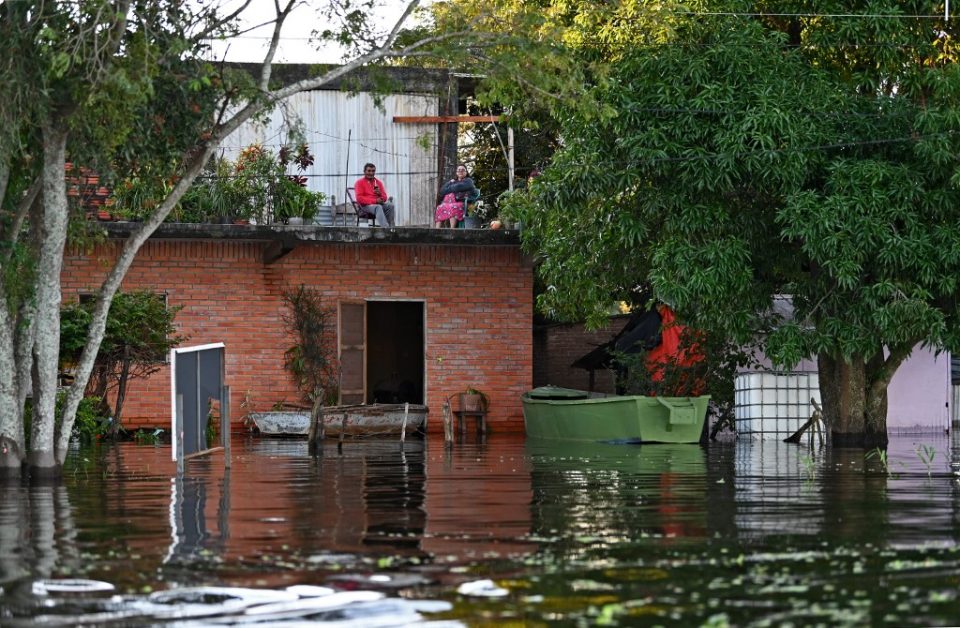
by Hugo OLAZAR
NANAWA, Paraguay (AFP) — Like 70,000 people living close to the broken banks of the Paraguay River, where the water level has risen seven meters (23 feet) in some places, Graciela Acosta has had to pack up her belongings and evacuate.
Piled up on a canoe are the 39-year-old housewife’s bed, wardrobe, bedside table and her dog Pirulin.
Acosta is getting ready to cross the border into Argentina with her daughter to seek refuge in a reception center in the neighboring town of Clorinda.
“I’ve had enough! It’s the third time that I’ve had to move everything because of the floods,” said Acosta.
“I pray to God that it ends. Every time. it costs a lot of money.”
However, there’s no chance of Acosta leaving her home in Nanawa, a town of just 6,000 people that borders Argentina to the west and faces the capital Asuncion to the east across the Paraguay River, for good.
“As soon as the water level drops, I’ll go home,” she said.
– ‘Greater impact’ –
In Nanawa, only around 500 people were able to avoid evacuation, due to living in homes with upper floors above the flood levels.
They’re used to this as the Paraguay River, one of the largest in the Americas, breaks its banks and causes havoc in the poorest Nanawa neighborhoods built on the flood plain.
The river’s brown waters rise almost to the height of street signs: in some areas, there is up to one or two meters of water covering roads.
Paraguayans have seen worse, though, back in 1983, according to the assistant director of the country’s meteorology and hydrology service, Nelson Perez.
“It’s not the Paraguay River’s worst flood, but the impact is greater because more people live close to the river,” said Perez.
“These are the worst floods I’ve seen,” said Ruben Acosta, 55, who peddles his moving services by canoe.
It’s a far cry from January and February, when the river’s level was so low that navigating it became difficult.
“It rained a lot in March, three times more than usual, and it also rained a lot in April and May,” said Perez, who pointed to deforestation as an added problem.
‘It’s like being in Venice’
Wading through water up to his chest, Rigoberto Nunez leaves a cemetery carrying a chandelier, a vase, some crucifixes and family portraits, all plucked from the family vault.
“I prefer to take them away to be safe,” says the 47-year-old traveling salesman.
The town is without electricity or police and inhabitants are afraid of looters.
Nunez is heading to a reception center provided by Argentine authorities in a Clorinda slum where he’s already stashed his furniture.
Enrique Cardozo’s workshop has already been ravaged by the floods.
“I’ve lost my sofa, the cupboard, I had nowhere to put them,” said the 51-year-old father of four.
The family has moved into the first floor of their house, which is just 15 meters from the river.
“It rained non-stop for a week. One day, the water rose one meter. It was impressive, we couldn’t save everything,” said Cardozo.
“There’s nowhere you can put your feet on the ground. It’s like being in Venice, we move about by Gondola!”
On the other side of the river, Asuncion has not been spared as several areas have also had to be evacuated.
In the Sajonia residential zone, inhabitants and shopkeepers have seen their sidewalks lined with sandbags, to keep back the floodwaters.
According to Perez, though, the problems — and waters — will soon subside.
The water level rose only slightly on Monday, and will continue to do so for a few more days before it drains away during the first half of June, he said.
© Agence France-Presse
